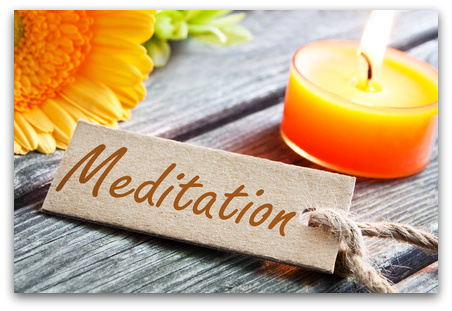Kevin Schoeninger specialises in mind-body training, in today’s guest post he shares some of his expertise and experience in:
How to Set Up For Successful Meditation
By Kevin Schoeninger

What is the current status of your meditation practice? Is it in the idea stage, waiting to be implemented at the right time? Maybe you know it’s something that would be good for you, but haven’t yet clicked into doing it as a daily routine?
Or maybe, you’ve done it at times, but either been frustrated by the results or lost interest? Or perhaps, you love to meditate and would like to gain some insights about how to go even deeper or make it even more effective?
In this article, we explore 4 Steps to Setup a Successful Meditation Session.
1. Set Up a Meditative Space
Whether it’s a spare room, a closet, or a part of your bedroom, define a space that you dedicate to meditation. You can mark this space with a rug, a meditation bench, chair, or cushion.
By meditating in the same space consistently it comes to represent “meditation” to you, and thereby becomes a space that supports you moving into a meditative state. After a period of time, just sitting in this space will relax you.
Another way to enhance the atmosphere of your meditation space is to set up an “altar” that represents what is important to you in your practice and your life.
If the idea of having an altar inspires you, it can take any form that is pleasing and motivating to you. It can include photos, symbols, candles, flowers, offering bowls, statues, quotes, and so on. The basic idea is to put significant items there-ones that put you in the right mindset for meditating and remind you WHY you are taking time to practice.
If you use meditation to support a religious faith, place images or items that represent your faith on your altar. Personally, I have symbols of several different spiritual traditions in my space to represent the Universal Spirituality underlying all faiths and traditions. I also have family pictures and quotes that remind me of my higher intentions. The most important quality of your altar is that it represents what is important to you.
Once you’ve meditated in your sacred space for a while and used it to grow your inner skills, you’ll be able to take your meditation on the road and do it virtually anytime, anywhere-no matter what is going on around you. This is when your meditation becomes truly powerful. Yet, even then, you’ll probably really appreciate and value those times when you get to meditate in your sacred space.
2. Create a Ritual Around Your Practice
Set a regular time for meditation and create a consistent routine that moves you into your practice.
One way to support regular practice is to make meditation a part of an established routine that you already do. For most people, the best way is to integrate meditation into their morning routine. This encourages you to start your day from a relaxed, present, intentional perspective-and it insures that you meditate before other events in the day get in the way.
Once you’ve decided on the time you will meditate, plan your day accordingly. If you are meditating first thing, make sure you go to bed early enough that you can comfortably wake up early enough to practice without rushing. Set your alarm to wake you up with plenty of time.
Once you get up, have a routine to move you into your practice. For example, I first massage around my eyes and back of my head while still lying in bed. I then massage the bottoms of my feet with some tennis balls that are at the foot of my bed when I sit up. I use the toilet, then splash water on my face and massage my scalp. Then, I do some stretches to limber up before I stand in my standing meditation posture. All of this awakens and loosens me up and prepares me for a good practice session.
After standing meditation, I do a seated meditation, then I shake out my whole body, and finish with prayers for my family and the whole planet at my altar.
Having a routine that includes how I wake up, makes the movement into my practice seamless and reliable. Over the years, I have adapted and grown my routine as needs, insights, and new learning have guided me. Yet, the basic idea of having a ritual sequence has made waking up something that I look forward to and moving into my practice easy and natural.
3. Adjust Your Posture
If you search for photos of people meditating, nine times out of ten you’ll find them seated in a cross-legged position. Unfortunately, this gives many people the impression that this is THE WAY to meditate. I heartily disagree.
In fact, unless you’ve grown up in a culture in which that is the way you normally sit, I encourage you to sit on a chair, bench, or bed that puts the soles of your feet flat on the floor and parallel with each other, with your hips level with or slightly above your knees.
Having the soles of your feet flat on the floor and parallel to each other puts you in a “grounded” position that also bio-mechanically aligns your feet, knees, and hips. This position is easy on your joints.
There are many acceptable hand positions for meditation-each with their own purpose. A basic starting position is to place your hands palms-down on your legs. This position is relaxing, while it also supports upright posture and alert attention. Finer points are “softening” your hands and lowering your shoulders to release tension and having a slight space under your armpits to encourage an open, expansive, spacious feeling in your body.
Next, imagine a string attached to the top of your head, drawing your spine into an upright position. Tuck your chin slightly to lengthen the back of your neck and put a subtle smile on your lips to encourage a calm, accepting, positive attitude.
Lightly close your eyes to support you in focusing inwardly. Unless you are using a technique that focuses on energy above your head, direct your gaze slightly downward. After practicing a while, you may notice that your eyes naturally open just slightly, with a soft focus to the outer environment.
Finally, sit forward on the front edge of your seat. Sit far enough forward so you feel some weight in your feet, which encourages a grounded, present feeling in your body. Sitting without back support also aligns and strengthens your spine, which has an empowering affect.
As you align and strengthen your spine, you are more likely to stay aligned with your higher intentions and feel strong in following them, rather than getting distracted and swayed by less important desires. You develop a strong “backbone.”
Now, many people email me saying that this posture is just too hard and painful to maintain.
The reason for that is tension along the spine, weakness, and misalignment. Meditation practice is actually a powerful way to overcome these issues. First it reveals those issues, then it heals those issues.
During your meditation, you become aware of spinal tension, weakness, and misalignment. And, yes, that doesn’t feel so good, initially. Yet, if you can accept it and observe it without judgment, without fighting it, over time, you’ll notice that the tensions release, the spine adjusts, you come into alignment, and get stronger.
A well-known meditation teacher, Dr. Meares, says that some discomfort when starting to meditate is actually a good thing, because it teaches you to be able to observe discomfort without reacting, judging, or running away from it. As you calmly sit with discomfort, over time, it resolves and changes for the better. This is a powerful lesson to take with you into any uncomfortable situation in life. Be calmly present, relax and observe things non-judgmentally, then notice resolutions as they arise.
All that being said in favor of sitting upright without back support, you might approach this incrementally. Start by sitting forward for just a minute or two, calmly observe any discomfort until it is just too distracting, then sit back against support for the remainder of your practice. Gradually increase the amount of time that you sit in an unsupported upright position. After practicing for a period of time, this will actually become a comfortable, relaxed, and empowered way for you to sit.
One caveat is that some people cannot sit this way due to severe physical impairments. If that is the case, you can use back support or even lie down to meditate. If you do that, simply try to keep your spine as straight as possible by imagining that string extending your spine, tuck your chin slightly, adopt a subtle smile, soften your hands, and lightly close your eyes.
4. Adopt the Three Noble Principles-Good in the Beginning, Good in the Middle, Good at the End
In their book, “Meditation: An In-Depth Guide,” Ian Gawler and Paul Bedson share these three principles for meditation practice.
“Good in the Beginning” means that when you start a meditation session call to mind your intention, your motivation for practicing. You might want to “relax, to be calm, to let go of stress, to be well, to heal. But what is suggested here is that the more we can expand our motivation, the more encompassing our motivation, the more meaningful our meditation becomes, the more we will value it, the more likely we are to do it, and the more benefit it will bring.” (p.69, Meditation: An In-Depth Guide)
Consider how your meditation practice will have a positive impact on your day, on your interactions with others, and even on the collective consciousness of “all of us together.” What if your practice is making a positive contribution not only to your life, but also to the lives of others, and to all life on Earth?
In the Buddhist tradition, the goal of meditation practice is enlightenment, so that we can use our enlightenment to bring enlightenment to all beings. In the Christian contemplative tradition, meditation leads us into deeper communion with God, so that we bring Divine Love and Light into the world. In a mind-body view of meditation, we come into a relaxed, expanded, focused state so that we heal our wounds, grow our inner skills, be more effective in anything we do, and more caring and compassionate with others.
What motivates you to meditate?
“Good in the Middle” has to do with your attitude during meditation. The attitude to practice is calm, present, non-judgmental awareness of whatever happens. Recognize whatever comes up, accept it, release it, and return to your focal cues.
“Good in the End” has to do with how you finish your practice. Rather than rushing off into your day, it’s important to end intentionally and even to dedicate your practice to someone or something beyond yourself. From a meditative state you can more easily visualize positive outcomes for yourself, others, and the planet. You are also in a powerful state from which to pray. You can use your meditation to connect to a greater mission in life, such as being a vessel for Spirit to be more present in the world.
As you end your meditation think of how the skills you developed and the state of being you entered can have a greater impact in the larger whole.
When you Set Up a Meditative Space, Create a Ritual Around Your Practice, Sit with Good Posture, and Adopt the Three Noble Principles, your meditation practice will become much easier and more enjoyable, significant, and successful.
Enjoy your practice!
Looking for a powerful proven technique to quickly shift you into an empowered meditative state? Click Here to download The Core Energy Technique to release anything that holds you back, connect to your heart, and raise your vibration!
About Kevin Schoeninger
Kevin Schoeninger’s lifework is mind-body training through daily practice. He graduated from Villanova University in 1986 with a Master’s Degree in Philosophy and is certified as a Personal Trainer, Qigong Meditation instructor, Life Coach, and Reiki Master Teacher.
Kevin’s published programs include:
- The Power of Practice Program
- Learn Qigong Meditation Home Study Course
- RAISE YOUR VIBRATION: A Guide to Core Energy Meditation
- The Life You Are Meant To Live Program
- Holistic Fitness Training Program
- SpiritualGrowthMonthly.com
His programs are available online through The Mind-Body Training Company: Feel free to email Kevin with your questions through the link on The Power of Practice Home Page:
Connect with Kevin Schoeninger on Social Media
Twitter: https://twitter.com/PowerOfPractice
Article Source: How to Set Up For Successful Meditation
Ezinearticles Expert Page: Kevin Schoeninger

![]() What does success mean for you?
What does success mean for you?![]() If it didn’t matter if you were successful or not, what action would you take on a project that you’re currently working upon?
If it didn’t matter if you were successful or not, what action would you take on a project that you’re currently working upon?![]() What is one thing you could do that would increase you liking yourself, liking what you do or how you do it? – what else?
What is one thing you could do that would increase you liking yourself, liking what you do or how you do it? – what else?![]() If your brief for a project was to play whilst working on it – what would you be doing differently?
If your brief for a project was to play whilst working on it – what would you be doing differently?![]() If it really doesn’t matter what your age is, what would you be doing?
If it really doesn’t matter what your age is, what would you be doing?![]() What questions and thoughts do theses quotes prompt for you?
What questions and thoughts do theses quotes prompt for you?![]() If you are sharing a message do you actually want people to take a specific action as a consequence of your message? – If you do is it actually clear to others that action is an option and how they can take that action?
If you are sharing a message do you actually want people to take a specific action as a consequence of your message? – If you do is it actually clear to others that action is an option and how they can take that action?![]() If you were allowed to play with the language in a message you want to deliver how else could you word/deliver that message?
If you were allowed to play with the language in a message you want to deliver how else could you word/deliver that message?

 Jen Waller is on a mission to support, nurture and encourage coaching skills and talents from non-coach to coach and beyond.
Jen Waller is on a mission to support, nurture and encourage coaching skills and talents from non-coach to coach and beyond.


 Anna-Marie is a performance coach who draws from NLP, sports psychology, neuroscience, positive psychology and mindfulness theory to craft industrious and dynamic coaching partnerships with clients who yearn for more and desire balance within their life. Anna-Marie’s specialty is “walking & talking” where the Great Outdoors inspires facilitates deep level insights, encourages different perspectives and ultimately optimises performance. She integrates Analytic-Network (http://www.analyticnetwork.com) and mBraining (
Anna-Marie is a performance coach who draws from NLP, sports psychology, neuroscience, positive psychology and mindfulness theory to craft industrious and dynamic coaching partnerships with clients who yearn for more and desire balance within their life. Anna-Marie’s specialty is “walking & talking” where the Great Outdoors inspires facilitates deep level insights, encourages different perspectives and ultimately optimises performance. She integrates Analytic-Network (http://www.analyticnetwork.com) and mBraining ( For more information on Anna-Marie’s performance coaching services, visit
For more information on Anna-Marie’s performance coaching services, visit